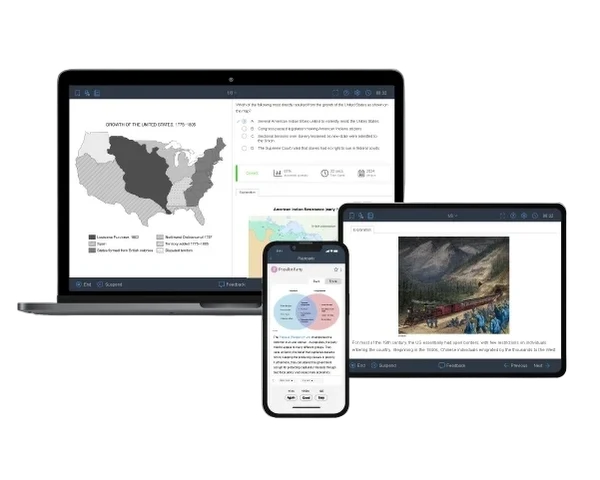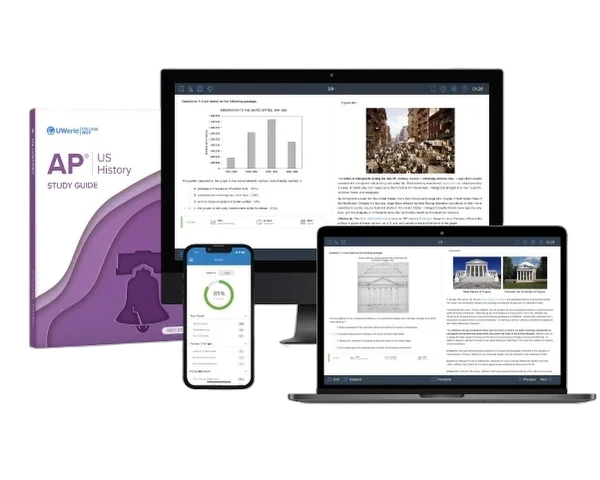If you are a high school student enrolled in AP® U.S. History or are self-studying for the APUSH exam, you know how important the APUSH end-of-course exam is. The 3-hour and 15-minute AP U.S. History exam assesses students’ knowledge of U.S. history (1491 to present). In addition, it tests you on specific skills and course objectives listed on the College Board®’s APUSH course and exam description. Because it is a heavyweight course, scoring well on the APUSH can impact your college admissions and get you college credit and placement.
Gaining a strong grasp of the exam's scoring framework can offer you numerous advantages in achieving a high score. Understanding the scoring of each section empowers you to strategize your study plan, focusing on growth opportunities to boost your outcomes. Additionally, you'll gain insights into time management, ensuring you have ample time for review before the exam concludes.
How Is the AP U.S. History Exam Scored?
Section I of the AP U.S. History exam has 55 multiple-choice questions (MCQs) and 3 short-answer questions (SAQs), accounting for 60% of the total score. Remember, there's no penalty for incorrect answers, so don't hesitate to make an educated guess.
Section II includes one document-based (DBQ) question and one long essay (LEQ) free-response question, accounting for 40% of the total score. Let's take a quick look at the 2024 APUSH exam’s scoring structure:
| Sections | Parts | Question Type | Raw Points | Score Weight |
|---|---|---|---|---|
| Section I (60 %) | Part A | 55 MCQs | N/A | 40 % |
| Part B | 3 SAQs | 9 points | 20 % | |
| Section II (40 %) | Part A | 1 DBQ | 7 points | 25 % |
| Part B | 1 LEQ | 6 points | 15 % |
The points you see are added together and converted to a raw score for the FRQ section. Similarly, a raw score is derived for the MCQ section, and these scores are added together to derive the composite score. This composite score is then converted to a scaled score of 1 to 5.
Continue reading to learn how the AP U.S. History examination is scored for each question type.
Multiple Choice Questions (MCQs)
The multiple-choice section's raw scoring is straightforward. The machine calculates your raw score for Section I, Part A, based on the number of questions you answered correctly. Remember that this section accounts for 40% of your total score.
There's no point deduction for wrong answers, so fill in every answer bubble.
Short Answer Questions (SAQs)
Each short-answer question is worth 3 points. As a result, your answers to the three SAQs can earn you 9 points. These questions account for 20% of your AP score.
Document-Based Question (DBQ)
The DBQ will account for 25% of your final grade and will be graded using the 7-point rubric below.
| Reporting Category | Points | Scoring Criteria |
|---|---|---|
| Thesis/Claim (0–1 point) |
1 pt. | Responds with a historically justifiable claim or thesis and a line of reasoning. |
| Contextualization (0–1 point) |
1 pt. | Provides historical background for the prompt. |
| Evidence (0–3 points) |
Evidence from the documents 1 pt. Or 2 pts. |
If your response to the prompt is supported by at least three documents, it will be considered appropriate. Or If your answer supports a claim with six supporting documents, |
| + | + | |
| Evidence beyond the documents 1 pt. |
To argue about the prompt, you must use at least one piece of historical evidence beyond the documents. | |
| Analysis and Reasoning (0–2 points) |
Sourcing 1 pt. |
Respond to the prompt using at least three documents to explain why the perspective, purpose, historical context, or audience of a document is relevant to an argument. |
| Complexity 1 pt. |
To respond to this prompt, support, qualify, or modify an argument that addresses the question with evidence. |
Long Essay Question (LEQ)
The LEQ accounts for 15% of your final grade and is graded using the 6-point rubric below:
| Reporting Category | Points | Scoring Criteria |
|---|---|---|
| Thesis/Claim (0–1 point) |
1 pt. | Provides a historically defensible thesis or claim in response to the prompt. |
| Contextualization (0–1 point) |
1 pt. | Provides relevant historical context. |
| Evidence (0–2 points) |
1 pt. Or 2 pts. |
Provides evidence pertinent to the prompt. Or Responds to the prompt with specific and pertinent evidence. |
| Analysis and Reasoning (0–2 points) |
1 pt. Or 2 pts. |
Responds to the prompt using historical reasoning (such as comparison, causality, continuity, and change). Or Utilizes evidence to substantiate, qualify, or modify an argument that addresses the question. |

AP U.S. History Scoring Table
Your total exam score is weighted to generate a final score between 1 and 5. Each score represents a unique performance. Colleges use these APUSH scores to determine who will receive free credit and placement. To be eligible for college credit, students must earn a score of at least 3 on the exam. Your AP United States History examination results are sent to your chosen colleges.
These scores are the result of extensive research conducted by The College Board. The primary objective of AP U.S. History is to teach you college-level history fundamentals while you are still in high school. Consequently, the board ensures that a student's performance, as calculated by their final APUSH exam score, is equivalent to that of a student in a college-level history course.
The table below illustrates how AP U.S. History scores are converted into college-grade equivalents.
| AP Exam Score | College Grade Equivalent | Qualification |
|---|---|---|
| 5 | A+ or A | Extremely well qualified |
| 4 | A-, B+, or B | Well qualified |
| 3 | B-, C+, or C | Qualified |
| 2 | — | Possibly Qualified |
| 1 | — | No recommendation |
A score of 4 or 5 on the APUSH exam indicates solid mastery of the material. Some colleges may grant credit or advanced placement for scores of 3 or higher, while others might require a score of 4 or 5. Although a score below 3 signifies a limited grasp of the subject matter, research indicates that students who undertake AP courses and achieve a score of 1 or 2 outperform non-AP students in their introductory college courses.
AP U.S. History Score Distribution
AP U.S. History is one of the most popular social sciences courses offered by the College Board. In fact, based on the number of students who took the final exam, APUSH is second in popularity only to AP English Language and Composition, with 488,688 high school students taking it in 2024. You can read our AP U.S. History Exam Guide to discover the career benefits of taking the U.S. History exam.
Learning about the APUSH score distribution can help you gauge the performance of an average student on the exam. This can also give you a scale to measure your performance on AP US History practice tests and help boost your study schedule! Here is the APUSH score distribution for the last four years.
| AP Score | % of Students 2024 | % of Students 2023 | % of Students 2022 | % of Students 2021 |
|---|---|---|---|---|
| 5 | 12.8% | 10.6% | 10.8% | 10.1% |
| 4 | 33.3% | 14.8% | 15.6% | 15.9% |
| 3 | 26.0% | 22.1% | 21.9% | 21.2% |
| 2 | 19.4% | 22.7% | 23.0% | 21.6% |
| 1 | 8.4% | 29.8% | 28.8% | 31.2% |
In 2024, the mean score on the AP U.S. History examination was 3.23. Preparing for this exam significantly enhances the likelihood of securing a 5 on the AP U.S. History exam.
The AP U.S. History exam has long been a tough hurdle for students aiming for a 3 or higher. In 2022, just 48.3% met the standard, decreasing slightly to 47.5% in 2023. However, in 2024, the percentage surged to 72.1%.
Minimum Score Requirement for College Credits
Most colleges in the United States accept AP U.S. History scores for credit or advanced placement. Some colleges offer advanced placement, allowing you to skip the course without receiving credit. Achieving a minimum score of 3 on the AP U.S. History exam could potentially earn you as many as six college credit hours (compared to three for other AP courses). However, some schools require a 4 or 5 to grant these credits.
Each college has different AP score requirements. When preparing for the AP U.S. History exam, it is essential to understand the requirements for college admission.
The interpretation of AP scores can vary depending on the institution and the specific subject. It's recommended to check the policies of the colleges and universities you're interested in to understand how they use APUSH scores for admission, credit, or placement.
The most important way to begin exam preparation is through practice. It is essential to practice with exam-like questions and familiarize oneself with the rubric for free-response questions. Using an online learning tool like UWorld is beneficial because we provide:
- Hundreds of exam-style questions that mirror the format and difficulty of the APUSH examination.
- Detailed explanations accompanied by vivid illustrations that debunk misconceptions and bring history to life.
- Performance dashboard so that you can measure your progress and identify areas that require improvement.
If you prepare with UWorld, take an AP U.S. History practice exam, apply yourself in class, and follow a well-thought-out study plan, you will be well on your way to boosting your GPA and acing the APUSH exam. Try out our APUSH Course, including QBank and study guide to discover why students love UWorld's online learning tools for exam preparation.

Frequently Asked Questions (FAQs)
What is a good AP U.S. History score?
What is the average AP U.S. History score?
Why are AP U.S. History scores curved?
When were the AP U.S. History scores released in 2024?
How many people get a perfect score in AP U.S. History?
How do I get a 5 on the AP U.S. History exam?
These are some key skills that can help you get a 5 in AP U.S. History:
- Knowing the rubrics
- Quickly understanding primary sources
- Knowing what to memorize
- Doing multiple choice questions efficiently
- Focusing on the bigger picture without getting bogged down in the details.
References
- AP U.S. History Course and Exam Description - college board. (n.d.). Retrieved December 19, 2024, from https://apcentral.collegeboard.org/pdf/ap-us-history-course-and-exam-description.pdf
- Past AP United States History Score Distributions. (n.d.). apstudents.collegeboard.org. Retrieved December 19, 2024, from https://apstudents.collegeboard.org/about-ap-scores/score-distributions/ap-united-states-history
Read More About the AP U.S. History Exam
Looking for an easy-to-read AP U.S. History exam format? Discover the exam format in this simple guide that breaks down the exam components, question types on the exam, and more!
AP U.S. History Course and Exam DescriptionLooking for a simpler AP U.S. History course description? Visit this page for detailed info on course units, key topics, concepts, and other necessary details.
AP U.S. History Study Plan & TipsEnhance your AP U.S. History exam prep with expert tips, practice questions, and in-depth insights designed to help you succeed. Click here to learn more today!
Best AP U.S. History Study Guide ComparisonExplore top AP U.S. History study guides to find the best resources for the exam. Compare features, pros, cons and reviews to select the perfect guide for success.
Best AP U.S. History Prep Course ReviewSearching for top AP U.S. History prep courses? Read this review to compare the best courses and choose the perfect one for your success.
How to Self-Study for AP U.S. HistoryLearn effective tips and strategies to self-study for the AP U.S. History exam. Build confidence, master core concepts, and achieve a high score independently too.END REQUIREMENTS



